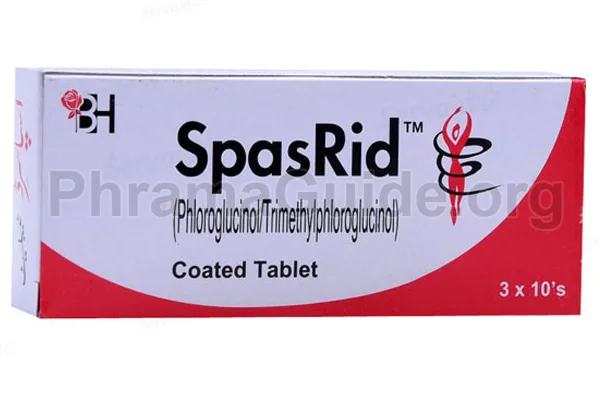Spasrid tablet is primarily used to treat gastrointestinal disorders such as diarrhea and indigestion. Spasrid is prescribed for the treatment of acute pain and spasms in the urinary tract and renal colic. Following are some common uses of Spasrid Tablet:
- Gastrointestinal Disorders: Spasrid tablet is often used in the treatment of gastrointestinal disorders characterized by spasms and abdominal pain. It helps to relax the smooth muscles in the gastrointestinal tract, providing relief from symptoms associated with conditions such as irritable bowel syndrome (IBS), colitis, and gastroenteritis.
- Urinary Disorders: Spasrid is also utilized in the management of urinary disorders. Using Sparid tablets helps to relieve spasms in the urinary tract, providing relief from symptoms such as urinary urgency, frequency, and pain. Conditions such as cystitis, ureteric colic, and overactive bladder may be treated with this combination.
- Menstrual Disorders: Spasrid is also used to alleviate menstrual cramps and associated symptoms. Using Spasrid tablets helps to relax the smooth muscles of the uterus, reducing pain and discomfort during menstruation.
- Spasmodic Pain: Spasrid tablets are used to relieve general spasmodic pain in various parts of the body. This can include pain due to muscular spasms, such as back pain, muscle strains, or tension headaches.
Other Uses of Spasrid Tablet
- Spasrid has also been found to be beneficial in treating inflammatory conditions including arthritis, asthma, ulcerative colitis, Crohn’s disease, and psoriasis by inhibiting the production of pro-inflammatory cytokines such as tumor necrosis factor-alpha (TNF-α).
Benefits of Using Spasrid Tablet
- Spasrid has also potential therapeutic benefits against cancer cells due to its antitumor properties. It can inhibit the growth of certain types of tumor cells by blocking signaling pathways involved in cell cycle regulation, which may make it useful as an anti-cancer agent. Furthermore, Spasrid can increase antioxidant activity which helps protect against oxidative stress caused by free radicals, which could lead to improved overall health outcomes over time if taken regularly at recommended doses under medical supervision.

What is Spasrid?
Spasrid is one of the leading brands of Phloroglucinol and Trimethylphloroglucinol, manufactured and marketed by Barrett Hodgson (Pvt) Ltd, Pakistan.
Spasrid Alternatives : Other Similar Brands
The following are some alternative brands of Spasrid and their manufacturers.
- Spasfon : Himont Pharmaceuticals (Pvt), Pakistan.
- Anafortan Plus : AGP (Pvt) Ltd, Pakistan.
- Spadix : Tabros Pharmaceuticals, Pakistan.
- Orglu : Sami Pharmaceuticals, Pakistan.
- Helispa Plus : Helix Pharmaceuticals, Pakistan.
- Gluthyl : Mass Pharma (Pvt) Ltd, Pakistan.
- Furosinol : Century Pharmaceuticals, Pakistan.
- Spastrim : Medera Pharmaceuticals, Pakistan.
- Spasmex : Angelini Pharmaceuticals (Pvt) Ltd, Pakistan.
Spasrid : Available Formulations and Strengths
Presently, Spsarid is available in Tablet, and Injection Forms
Spasrid Tablet : Phloroglucinol 40mg, and Trimethylphloroglucinol 0.04mg strengths
Spasrid Injection : Phloroglucinol 40mg, and Trimethylphloroglucinol 0.04mg strengths
Who Should Not Use Spasrid?
Despite the potential benefits of Spasrid uses discussed above, there are several contraindications that must be taken into consideration before beginning a course of treatment:
- Hypersensitivity: Individuals who have a known hypersensitivity or allergy to Spasrid’s ingredients (Phloroglucinol, Trimethylphloroglucinol) should avoid using this medication.
- Severe liver or kidney impairment: Patients with severe liver or kidney impairment may require dose adjustments or should avoid using Spasrid. This medication can be metabolized and eliminated by the liver and kidneys, and impaired organ function may affect their clearance from the body.
- Porphyria: Phloroglucinol (an active ingredient of Spasrid) has been associated with rare cases of acute porphyria exacerbation. Patients with a history of porphyria, a group of rare genetic disorders affecting the production of heme, should exercise caution or avoid medications containing Phloroglucinol and Trimethylphloroglucinol.
- Children and infants: The safety and efficacy of Spasrid in children and infants have not been well-established. Therefore, its use in this population may require careful consideration and medical supervision.
- Pregnancy and breast-feeding: The use of Spasrid during pregnancy and breastfeeding should be approached with caution. There is limited information available regarding its safety in these situations, and potential risks to the developing fetus or nursing infant should be weighed against the expected benefits.
What is the Recommended Daily Dosage of Spasrid?
Spasrid Tablet: Usual adult dose is 1 tablet 3 times a day, it can be increased by a maximum of 6 tablets in a day.
Spasrid Injection: 1 to 3 ampoules IM or IV a day.
How Spasrid Works?
Spasrid is a non-atropinic antispasmodic agent and works to reduce smooth muscle spasms by inhibiting the process of catechol-O-methyl transferase (COMT).

Leave A Comment